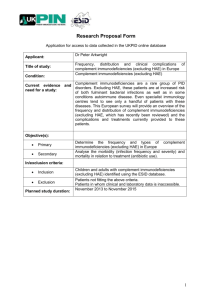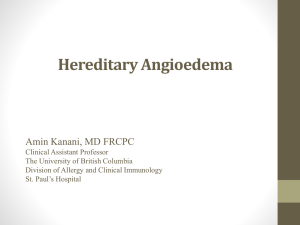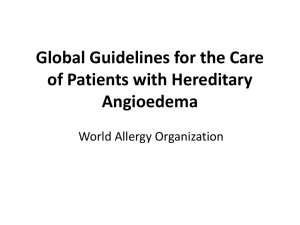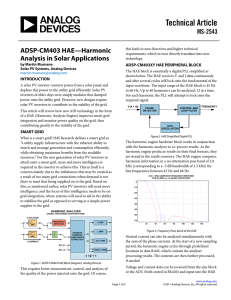Factsheet (English)
advertisement
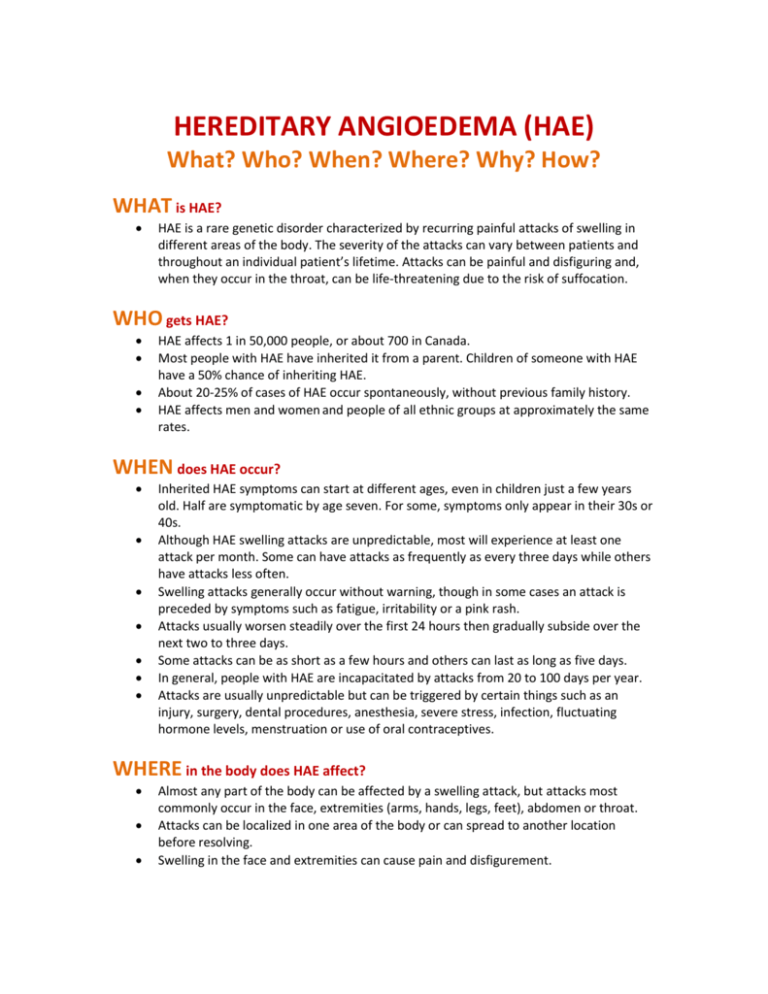
HEREDITARY ANGIOEDEMA (HAE) What? Who? When? Where? Why? How? WHAT is HAE? HAE is a rare genetic disorder characterized by recurring painful attacks of swelling in different areas of the body. The severity of the attacks can vary between patients and throughout an individual patient’s lifetime. Attacks can be painful and disfiguring and, when they occur in the throat, can be life-threatening due to the risk of suffocation. WHO gets HAE? HAE affects 1 in 50,000 people, or about 700 in Canada. Most people with HAE have inherited it from a parent. Children of someone with HAE have a 50% chance of inheriting HAE. About 20-25% of cases of HAE occur spontaneously, without previous family history. HAE affects men and women and people of all ethnic groups at approximately the same rates. WHEN does HAE occur? Inherited HAE symptoms can start at different ages, even in children just a few years old. Half are symptomatic by age seven. For some, symptoms only appear in their 30s or 40s. Although HAE swelling attacks are unpredictable, most will experience at least one attack per month. Some can have attacks as frequently as every three days while others have attacks less often. Swelling attacks generally occur without warning, though in some cases an attack is preceded by symptoms such as fatigue, irritability or a pink rash. Attacks usually worsen steadily over the first 24 hours then gradually subside over the next two to three days. Some attacks can be as short as a few hours and others can last as long as five days. In general, people with HAE are incapacitated by attacks from 20 to 100 days per year. Attacks are usually unpredictable but can be triggered by certain things such as an injury, surgery, dental procedures, anesthesia, severe stress, infection, fluctuating hormone levels, menstruation or use of oral contraceptives. WHERE in the body does HAE affect? Almost any part of the body can be affected by a swelling attack, but attacks most commonly occur in the face, extremities (arms, hands, legs, feet), abdomen or throat. Attacks can be localized in one area of the body or can spread to another location before resolving. Swelling in the face and extremities can cause pain and disfigurement. Attacks in the abdomen and intestinal wall are usually the most painful and can cause severe vomiting, diarrhea and cramping that can be mistaken for other conditions that require surgical intervention, such as appendicitis. Attacks leading to swelling in the throat are life-threatening medical emergencies that require prompt attention due to the risk of suffocation. WHY does HAE happen? HAE is the result of a problem with a protein called C1 esterase inhibitor or C1-INH. In Type I HAE, accounting for 85% of cases, C1-INH is decreased or not present at all. In Type II HAE, accounting for 15% of cases, C1-INH is present but does not work properly. A very rare form, Type III HAE, does not involve C1-INH. The lack of or problems with C1-INH mean the body’s systems that control inflammation are no longer regulated, eventually opening gaps in blood vessel walls through which fluid leaks to cause swelling. HOW is HAE diagnosed, prevented and treated? Because HAE is rare and the symptoms can be similar to other medical conditions, such as allergic reactions, diagnosis is often difficult and patients may be incorrectly treated. It can take eight years or longer for patients to get an accurate diagnosis. Some people with HAE have unnecessary abdominal surgeries when their attack is mistaken for other conditions. Two Health Canada approved treatments are available for HAE in Canada. Treatments exist to help reduce symptoms of an attack but need to be taken as early as possible to be most effective. Treatment for an attack is most effective when patients are trained and equipped to self-administer by intravenous infusion at home or by subcutaneous it as soon as an attack starts. Treatments can also be administered between attacks to help prevent them. New Canadian guidelines for the medical management of HAE were published in October 2014 and are available online. This fact sheet was made possible through the support of Shire Canada Inc.


